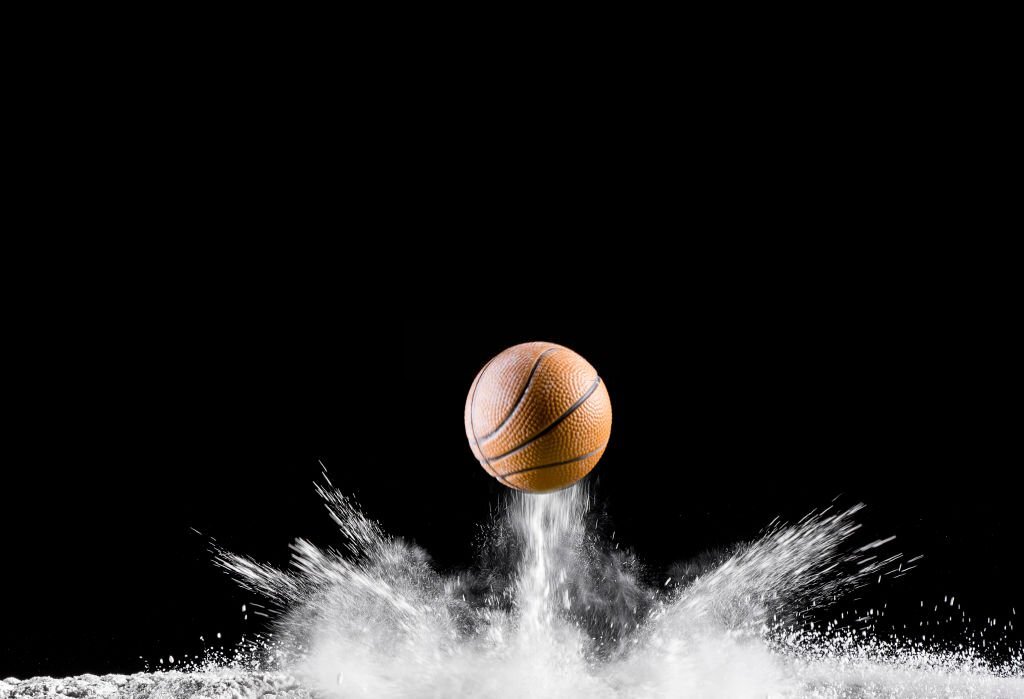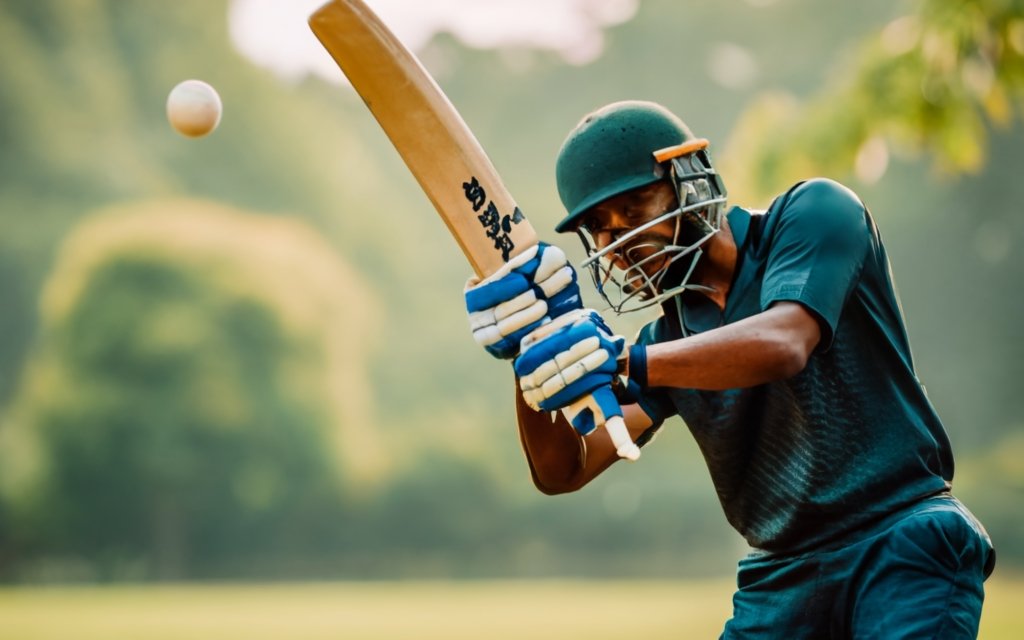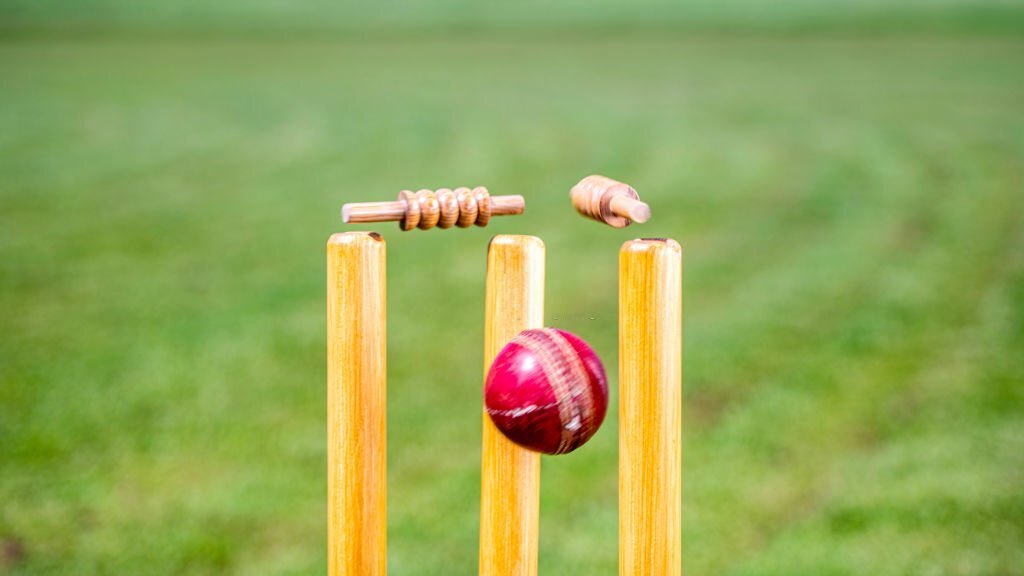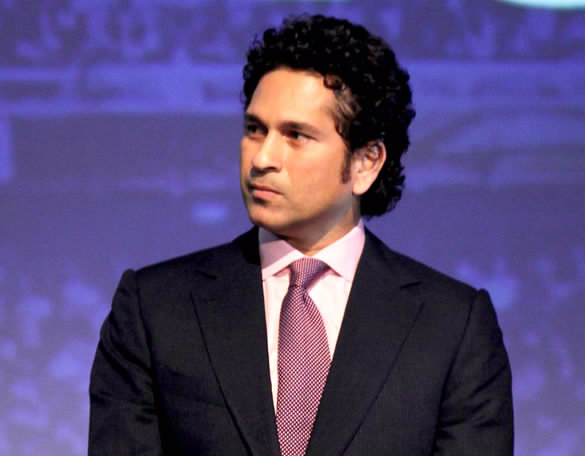Batting Tips
What Is Bump Ball In Cricket – Meaning & Definition

In cricket, a variety of terms are used that might seem perplexing to a beginner. Among these, one term that has sparked your curiosity might be the mysterious “Bump Ball“. Although it sounds complex, its concept is rather simple. Understanding it in Hindi or any other language, will only enhance your love for the sport.
a bump ball in cricket is when a batsman smacks the ball directly into the ground, causing it to be caught by a fielder.
Explanation of the term Bump Ball in cricket
The “Bump Ball” or in Hindi – “बम्प बॉल” is an integral part of cricketing terminology. So what exactly is it? In essence, when a batsman hits the ball and it bounces on the pitch before reaching the fielder, it is referred to as a Bump Ball.
You might ask how important it could be. The importance lies not merely in knowing what it means but understanding the role it plays. You see, many times fielders may assume they’ve taken a clean, direct catch when in reality the ball has bumped before reaching them. According to rules, such catches aren’t valid and batsman remains not out.
Mastering the ability to identify a Bump Ball as a player can significantly enhance your game skills. As a spectator, this term will help you better understand and enjoy watching cricket matches.
No matter whether you call it by its English moniker “Bump Ball” or its Hindi equivalent “बम्प बॉल”, becoming familiar with this technique can propel your understanding of cricket to another level. Therefore, keep enhancing your knowledge about such unique terms and enjoy this wonderful sport even more. So next time you watch or play cricket, remember to keep an eye out for that Bump Ball!
Definition of Bump Ball


Definition of Bump Ball ~ Image: Firefly
In the sport of cricket, a bump ball refers to a ball that is hit by the batsman and strikes the ground before rising back up. This can often lead to confusion for the fielding team, as it can be difficult to determine whether the ball has been cleanly caught or whether it has touched the ground.
Meaning and interpretation of Bump Ball in Hindi
The Hindi translation of bump ball is “उभार गेंद.” In cricket, this term is used to describe a situation where the batsman hits the ball and it bounces off the pitch before being caught by a fielder. The interpretation of this term in Hindi emphasizes the action of the ball rising or bouncing up after hitting the ground.
Cricket enthusiasts in India and other Hindi-speaking countries use this term to refer to specific situations during a match when there is doubt about whether the ball was caught cleanly or not. The concept of a bump ball adds an element of excitement and uncertainty to the game, as players and spectators eagerly await the decision of the umpire.
Understanding the meaning of bump ball in Hindi allows cricket fans to fully engage with and appreciate all aspects of the game. It enables them to participate in discussions, debates, and analysis about specific incidents involving this type of play.
By familiarizing yourself with this terminology, you can enhance your understanding of cricket and enjoy the sport even more. So, next time you watch a cricket match, pay attention to any bump ball situations and join in on the conversation of whether it was a clean catch or not.
When Do Bump Balls Usually Occur?
As someone who watches a lot of cricket, I’ve noticed that the most common moment for a bowler to hit a batsman with a bump ball is when they bowl a ball that is really full, like a yorker. If you are unfamiliar with the term “yorker,” it refers to a ball that is intended to fall very near to the batsman’s feet. Therefore, in order to prevent the ball from striking the stumps, the batter will frequently need to press down hard on the ball with their bat. When they do this, there is a good chance that the ball will move into the ground extremely rapidly and then bounce back up into the air, where it can be retrieved by a fielder who is positioned quite near to the bat. If all of this takes place in a timely manner, the bowler will begin to appeal, and then the discussion on whether or not the ball was bumped will get underway.
Usage of Bump Ball in Cricket
If you’re a cricket enthusiast and want to understand the meaning of “bump ball” in Hindi, you’ve come to the right place. The term “bump ball” refers to a specific situation in cricket that occurs when a batsman strikes the ball directly into the ground, resulting in the ball being caught by a fielder. This is a crucial term to grasp if you want to enjoy and analyze cricket matches effectively.
Examples and situations where Bump Ball occurs in cricket
- Yorker deliveries: Bump balls frequently occur when bowlers deliver full-length yorker balls, which aim towards the batsman’s feet. In such cases, batsmen often have to jam their bat down quickly, causing the ball to bounce off the ground and pop up in the air towards a fielder.
- Diving catches: Another scenario where bump balls occur is during diving catches. In these instances, fielders dive forward to take a catch, and the ball bounces fractionally in front of their hands. This can lead to confusion as it may appear that the ball is hitting the ground and being caught at the same time.
Understanding the concept of a bump ball will enhance your cricket knowledge and enable you to appreciate the game on a deeper level. So, next time you’re watching a cricket match, keep an eye out for those exciting moments when a batsman hits the ball directly into the ground, resulting in a potential catch by a fielder!
Rules and Regulations


Explanation of the rules and regulations regarding Bump Ball in cricket
If you’re someone who loves cricket chances are you’ve heard of the term “Bump Ball” during a game.. What exactly does it mean and how does it impact the matchs outcome? Lets delve into the rules and regulations that revolve around Bump Ball in cricket.
To put it simply a Bump Ball occurs when a batsman hits the ball directly into the ground causing it to bounce before being caught by a fielder. It’s an aspect of the game which demands careful judgment from umpires.
As per the rules if the ball is struck straight to a fielder without bouncing the batsman is declared out. However if its deemed as a Bump Ball – meaning it touched the ground after leaving the bat before being caught – then the batsman remains not out.
Differentiating between a catch and a Bump Ball can be quite challenging even with video replays. Umpires rely on their instincts and on field decisions unless there is evidence to overturn them.
Bump Balls typically occur when bowlers deliver full balls like yorkers and batsmen quickly jam their bat down onto them causing an immediate contact, with the ground and resulting in an airborne pop up.The phrase “Bump Catch” is used when a fielder dives forward to catch the ball. It bounces slightly in front of their hands. It can be quite challenging to determine whether the catch was clean or not.
Having a grasp of the rules and regulations related to Bump Ball in cricket adds an extra level of excitement and complexity, to this beloved sport. So the next time you’re watching a match pay attention to those decisions made by umpires when it comes to Bump Balls.
Impact of Bump Ball on the Game
When it comes to cricket, a bump ball can have a significant impact on the outcome of a match. It’s a term used to describe a catch taken by a fielder after the ball has made contact with the ground. However, it may appear to have been caught cleanly on the full without bouncing. Let’s delve into how bump ball affects the game.
Discussion on how Bump Ball affects the outcome of a cricket match
- Momentum Swing: A successful bump ball catch can swing the momentum in favor of the fielding team. It can break a batting partnership or provide a crucial breakthrough for the bowling side.
- Disputes and Controversies: Bump ball decisions often spark debates and controversies. Umpires have to make quick judgments based on visual cues and instincts. The introduction of technology like Snickometer and UltraEdge has helped in making more accurate decisions.
- Integrity of the Game: The accuracy of bump ball decisions is crucial for maintaining the integrity of the game. Players and spectators rely on fair judgments to ensure a level playing field.
- Strategic Importance: Batsmen and bowlers strategize their gameplay based on bump ball scenarios. Bowlers aim to induce bump balls by delivering full and fast balls, while batsmen try to avoid them by using their skills to keep the ball off the ground.
- Excitement and Intrigue: Bump balls add to the excitement and intrigue of cricket matches. The anticipation of whether a catch was taken cleanly or not keeps fans engaged in the game.
In conclusion, bump balls play a significant role in cricket matches, impacting momentum, sparking controversies, and adding excitement to the game. Accurate decision-making and the use of technology have become integral in determining whether a catch was cleanly taken or not after the ball has made contact with the ground.
Controversies and Decisions
When it comes to cricket, one term that often stirs up controversy is “bump ball”. This term refers to a catch taken by a fielder after the ball has made contact with the ground. The decision whether it was a clean catch or not can have a significant impact on the outcome of a match. Here are some instances where bump ball decisions have caused controversy in cricket.
Gooch’s Dismissal
In 1991, Graham Gooch’s dismissal against West Indies sparked a heated debate. The ball popped up off his pads and was caught by a fielder. Gooch protested, claiming it was a bump ball, but the umpire ruled it as a clean catch. This decision had a profound impact on the match.
Tendulkar’s Catch
In 1999, Sachin Tendulkar claimed a catch that was disputed by the batsman. The replays were inconclusive, but the decision went in favor of the fielding side. This incident raised questions about the accuracy of umpiring decisions and fueled further debates.
Pietersen’s Catch
In 2005, Kevin Pietersen was involved in a controversial catch claim. Despite doubts about whether the ball had touched the ground before being caught, the decision favored the fielding side. This incident highlighted the need for precise judgment in critical moments.
These examples illustrate how bump ball decisions can swing momentum, change partnerships, or provide crucial breakthroughs. Umpires play a crucial role in making these decisions, but technology like the Snickometer and UltraEdge are increasingly being used to aid in determining whether the ball made contact with the ground or not.
While technology has improved decision-making, controversies still arise due to differing interpretations of visual cues and evidence. Minimizing controversies requires continued technological advancements, proper training and support for umpires, and consistent decision-making to uphold the integrity of the game.
Bump Ball Techniques
Techniques used by batsmen and fielders to create or avoid Bump Ball situations
As a cricket enthusiast, you might be curious about the techniques used by batsmen and fielders to create or avoid bump ball situations. Let’s delve into these techniques and understand how they impact the game.
- For batsmen: To avoid bump balls, batsmen need to focus on their batting technique. They should aim to play the ball with a straight bat, ensuring that the ball makes clean contact with the middle of the bat. This reduces the chances of the ball rebounding off the ground and being caught by a fielder.
- For fielders: Fielders can use various techniques to try and induce bump balls from the batsman. They can bowl fuller deliveries, known as yorkers, which force the batsman to hit the ball into the ground. Fielders can also position themselves strategically to be in a position to catch any bump balls that may arise.
In addition fielders must remain vigilant. Possess quick reflexes to react promptly when faced with a situation involving a bump ball. They should position their hands correctly. Be prepared to seize any opportunities that come their way.
These techniques play a role in determining whether a bump ball occurs during a cricket match. Batsmen must master their technique to avoid providing fielders with catching chances while fielders need to be proactive and attentive in order to take advantage of any bump balls that may arise.
By understanding these techniques one can truly appreciate the skill required by both batsmen and fielders in creating or avoiding situations involving bump balls. It adds a layer of excitement and strategy, to the game of cricket.
Therefore the next time you watch a cricket match pay attention to these techniques. Observe how they influence the outcome of the game.
Importance of Bump Ball in Cricket
Cricket enthusiasts and players alike often come across the term “bump ball” during matches, but not everyone may be familiar with its meaning and significance. Let’s unravel the mystery behind this term!
Significance of Bump Ball in the game of cricket and its impact on gameplay
In the game of cricket, a bump ball occurs when a batsman strikes the ball directly into the ground causing it to bounce back up before being caught by a fielder. This particular occurrence has implications for gameplay.
Firstly a bump ball can create confusion among spectators, players and even umpires. The speed at which the ball makes contact with the ground and pops back up can make it challenging to determine whether the catch was cleanly taken or if the ball made contact with the ground.
Furthermore bump balls typically happen when a bowler delivers a full ball like a yorker forcing the batsman to quickly jam their bat down onto the ball to prevent it from hitting their stumps. This technique often leads to the ball bouncing rapidly and popping up towards a fielder.
Deciding whether or not a catch involving a bump ball was relies on both on field umpire judgment and sometimes video replays. The difficulty lies in obtaining evidence that proves whether or not the catch was clean or if indeed there was contact with the ground before it was caught.
Understanding what exactly constitutes a bump ball adds depth to your knowledge of cricket. Enables you to appreciate these intricate scenarios within matches. It highlights how even subtle details like a ball touching down briefly before rising can hold consequences, for players and game outcomes.
Time you find yourself watching or playing cricket and come across a situation where the ball hits the ground and then bounces up known as a bump ball you’ll gain a deeper appreciation, for its significance and how it can influence the game. Enjoy your cricket experiences whether as a spectator or participant!
Conclusion- Bump Ball Cricket
As a reminder, a bump ball in cricket is when a batsman smacks the ball directly into the ground, causing it to be caught by a fielder. This gives the impression that the ball was hit directly to the fielder without making contact with the ground. The fact that the ball bounces before being caught determines whether it is a bump ball or not.
Due to the quick and fast touch with the ground, detecting a bump ball can be difficult for spectators, players, and umpires. Umpires rely on their knowledge and experience, however technologies like as the Snickometer and UltraEdge are utilized to make more precise rulings.
Bump balls are often produced when a bowler throws a full ball, such as a yorker, that falls near the batsman’s feet. Because of the fast bat movement, the ball bounces off the ground and pops up for a close fielder to collect.
It is critical to make appropriate decisions on bump balls because they may influence match outcomes by changing momentum, batting partnerships, and giving significant breakthroughs.
Finally, knowing bump balls adds to the interest of the game of cricket. Pay attention to the close calls and controversies around this facet of the game the next time you attend a match.
Summary of the key points discussed about Bump Ball in cricket:
A bump ball happens when a batter knocks the ball directly into the ground, giving the impression that it was hit directly to the fielder without bouncing.- Umpires utilize their discretion and technology to assess if a ball is a bump ball.- Bump balls are common on yorker deliveries because the batsman’s fast bat movement forces the ball to ricochet off the ground.- Accurate decisions are vital since they may influence match outcomes and create pivotal moments in games.





“Hello, I’m Manish Dangi, the driving force behind cricketvalue.com. As a dedicated cricket writer and enthusiast, I bring you the latest insights, updates, and stories from the dynamic world of cricket. With a keen eye for detail and a love for the game, I aim to provide a valuable perspective on matches, players, and trends. Feel free to reach out at [email protected]. Let’s celebrate the spirit of cricket together at CricketValue!”
Batting Tips
What Is Bump Ball in Cricket?


Do you ever wonder why a ball in cricket sometimes hits the ground before being caught? Well, you’re not alone. In this article, we’ll explore the fascinating world of bump balls and unravel the mystery behind this unique occurrence.
Did you know that a bump ball occurs when a batsman jams their bat down on a very full delivery, causing the ball to bounce up towards a fielder? Join us as we delve into the definition, recognition, and impact of bump balls in cricket.
Key Takeaways
- Bump balls occur when a bowler delivers a very full ball, and the batsman jams their bat down on it to prevent it from hitting the stumps.
- Bump catches happen when a fielder dives forward to catch a ball that bounces fractionally in front of their hands, and it can be challenging to determine if the catch was clean or if the ball touched the ground.
- Umpires rely on their gut feeling to determine if a ball is a bump ball or if the catch was taken cleanly, and the decision can be challenged through video replay.
- Understanding the concept of a bump ball is important for cricket spectators to comprehend certain situations during a match and enhance their overall understanding of the game.
Definition
A bump ball in cricket is a type of occurrence where the bat hits the ball and the ground almost simultaneously. It’s recognized when the bat makes contact with the ball and then the ground in quick succession. The ball then lobs in the air and lands into the hands of a fielder after hitting the pitch first.
Both the batter and the fielder are aware of a bump ball event in most cases. Fielders may sometimes pretend to celebrate the fall of wicket to engage the crowd, leading to momentary confusion. The crowd often reacts with excitement, thinking it’s a dismissal, but then realizes the batter isn’t out.
Bump balls provide relief to batters and frustration to bowlers, as they allow batters to continue their innings without being dismissed.
Recognition
To recognize a bump ball in cricket, you need to observe the bat making contact with the ball and then the ground almost simultaneously. From an umpire’s perspective, this can be a challenging decision to make in real-time.
The fielder’s role is crucial in providing additional insight into whether the ball hit the ground or not. Common misconceptions often arise when spectators mistake a bump ball for a clean catch, leading to excitement followed by disappointment.
The strategic implications of a bump ball are significant, as it allows the batsman to continue their innings without being dismissed. Historical incidents have shown that fielders may try to exploit the confusion and celebrate a bump ball catch to engage the crowd.
Understanding the recognition of a bump ball in cricket is essential for both players and spectators to fully grasp the dynamics of the game.
Dismissal
When it comes to bump balls in cricket, it’s important to understand that despite appearances, a batter can’t be dismissed off a bump ball. This ruling is based on the fact that the ball must touch the ground before being caught in order for the batter to be considered out.
Here are five key points to consider regarding the dismissal of a batter off a bump ball:
- Umpire ruling: The on-field umpire is responsible for making the final decision on whether the catch was taken cleanly or not.
- Fielder’s role: The fielder must demonstrate control over the ball without it touching the ground in order for the catch to be considered legitimate.
- Batsman’s perspective: The batsman may feel relieved when a bump ball is caught, as they can’t be dismissed off it.
- Controversial decisions: There have been instances where controversial decisions have been made regarding bump ball catches, leading to debates and discussions among players, officials, and spectators.
- Importance of technology: The introduction of technology, such as slow-motion replays, has helped in making more accurate decisions regarding bump ball catches, reducing the chances of controversial calls.
Spectator Reaction
As a spectator, your reaction to a bump ball catch in cricket can range from initial excitement to eventual disappointment.
When a fielder dives forward to catch a ball that bounces fractionally in front of their hands, it creates moments of humor and entertainment during a cricket match. The crowd’s excitement may be heightened if the fielder pretends to celebrate the fall of wicket, engaging the spectators in the stadium.
However, when they realize that the batter isn’t out, disappointment and drama fill the air. Bump ball catches provide relief for batters, allowing them to continue their innings without being dismissed.
The unpredictability and excitement of bump balls contribute to the overall atmosphere and engagement of the game.
Impact
Bump balls have a significant impact on the game of cricket, providing relief to batters and adding excitement and unpredictability to the overall atmosphere of the match. Here are five key ways in which bump balls influence the game:
- Impact on fielding: Bump balls challenge fielders to quickly react and make difficult catches, testing their skills and agility.
- Strategic advantage: Batters can use the occurrence of a bump ball to their advantage, as it allows them to continue their innings without being dismissed.
- Psychological impact: Bump balls can create confusion and frustration for bowlers, who are unable to claim a dismissal despite seemingly catching the ball.
- Role of umpires: Umpires play a crucial role in determining whether a bump ball has occurred or if a catch is clean, relying on their judgment and video replays.
- Impact on batting strategy: Bump balls can influence a batter’s approach, as they may be more inclined to play aggressively knowing that they’ve the safety net of a potential bump ball.
Understanding the impact of bump balls sets the stage for the subsequent discussion on umpire decisions.
Umpire Decision
To judge the outcome of a bump ball in cricket, umpires rely on their decision-making skills and video replays. When a potential bump catch occurs, the on-field umpire makes an initial call based on their perspective and judgment.
However, if there’s any dispute or if the catch appears to be a clean catch, the umpire may send the decision to the third umpire for a review using the video review process. The third umpire carefully watches the tape from multiple angles to decide if the ball touched the ground before being caught. This review takes into account both the fielder’s perspective and the batsman’s perspective.
If there’s clear evidence that the ball hit the ground, the hitter will be given not out. However, if there’s uncertainty, the on-field decision will stand. This decision-making procedure provides justice and precision in determining the outcome of a bump ball situation.
Moving on to technical tips…
Technical Tips
Improve your cricket skills with these technical tips for enhancing your batting, bowling, and fielding abilities.
- Work on your batting technique by practicing proper footwork, balance, and shot selection. Focus on playing straight and using your wrists effectively.
- Develop your fielding skills by practicing catching, throwing, and agility drills. Work on your reaction time and positioning on the field.
- Experiment with different bowling variations to keep the batsmen guessing. Practice variations like slower balls, cutters, and spin to add variety to your bowling arsenal.
- Incorporate cricket drills into your training routine to improve your overall game. Practice specific skills like running between the wickets, playing different shot types, and working on your bowling accuracy.
- Develop game strategies to outsmart your opponents. Study the strengths and weaknesses of the opposition, analyze match situations, and adapt your gameplay accordingly. Stay calm and focused under pressure to make wise decisions on the field.
Video Replay
You can enhance your understanding of bump balls in cricket by exploring the role of video replay. In recent years, the role of technology has become increasingly important in cricket, especially in making decisions regarding bump balls.
Video replay has been introduced to address the challenges faced by umpires in determining whether a catch was taken cleanly or if the ball touched the ground. This has led to some controversial decisions, as slow-motion replays can sometimes reveal minute details that are difficult to observe in real-time.
The impact of video replay on the game strategy has been significant, as teams can now challenge umpire decisions and potentially overturn them. Moreover, video replay has improved umpire accuracy, ensuring fair play and reducing errors.
With the introduction of video replay, the game of cricket has become more precise and transparent, providing a fairer playing field for all teams. Moving forward, let’s delve into the role of the on-field umpire in making these crucial decisions.
On-Field Umpire
The role of the on-field umpire in determining the legitimacy of a bump ball is crucial in maintaining the integrity of the game. The on-field umpire plays a pivotal role in making decisions related to bump balls and bump catches.
Here are five key aspects of the on-field umpire’s role in this regard:
- Umpire Communication: The on-field umpire communicates with the players and the third umpire to ensure a fair decision.
- Umpire Signals: The on-field umpire uses specific signals to indicate the outcome of a bump ball or a bump catch.
- Umpire Authority: The on-field umpire has the authority to make the final decision on whether a catch was taken cleanly or if the ball hit the ground.
- Umpire Decision Making: The on-field umpire uses their judgment and experience to make quick decisions in real-time situations.
- Umpire Training: Umpires undergo rigorous training to enhance their decision-making skills and stay updated with the rules and regulations of the game.
The on-field umpire’s expertise and decision-making abilities are vital in ensuring fair play and maintaining the spirit of the game.
This understanding of the umpire’s role leads us to explore miscellaneous information about cricket.
Conclusion
In conclusion, bump balls in cricket bring both excitement and confusion to the game. They occur when a batsman jams their bat down on a very full ball, causing it to hit the ground before being caught.
Spectators react with awe and anticipation, while players are left with the challenge of recognizing and dismissing these tricky shots.
By understanding the impact and intricacies of bump balls, you can appreciate the unique dynamics they add to the game of cricket.
Frequently Asked Questions
How Can a Batsman Prevent a Bump Ball From Occurring?
To prevent a bump ball, you, as the batsman, can use techniques like playing with soft hands and keeping the bat close to the body. Fielders can reduce bump ball occurrences by staying alert and taking catches cleanly.
Can a Fielder Intentionally Pretend to Celebrate a Bump Ball Catch?
Can a fielder intentionally pretend to celebrate a bump ball catch? This raises questions about fair play and sportsmanship. The fielder’s role in creating confusion impacts the game, while the umpire’s decision determines the outcome and potential controversy.
Are There Any Specific Rules or Regulations Regarding Bump Balls in Cricket?
There are specific rules and regulations regarding bump balls in cricket. The umpire plays a crucial role in determining if a ball is a bump ball. Technology, such as video replay, has impacted the detection of bump balls. Famous incidents and fielding positions also contribute to bump ball controversies.
How Often Do Bump Balls Occur in a Typical Cricket Match?
Bump balls occur sporadically in cricket matches, their frequency varying depending on factors like pitch conditions. They add excitement and unpredictability to the game, often challenging umpire decisions and impacting gameplay.
Are There Any Strategies or Techniques That Fielders Use to Increase the Chances of a Bump Ball Catch?
Fielders can strategically position themselves closer to the batsman to increase chances of a bump ball catch. Effective communication techniques, reflex training, anticipation skills, and proper body positioning are crucial for successfully taking such catches.





“Hello, I’m Manish Dangi, the driving force behind cricketvalue.com. As a dedicated cricket writer and enthusiast, I bring you the latest insights, updates, and stories from the dynamic world of cricket. With a keen eye for detail and a love for the game, I aim to provide a valuable perspective on matches, players, and trends. Feel free to reach out at [email protected]. Let’s celebrate the spirit of cricket together at CricketValue!”
Batting Tips
5 Cricket Batting Tips for Perfect Footwork and Timing


Are you ready to take your cricket batting to the next level? Want to improve your footwork and timing for those perfect shots? Look no further!
In this article, we will share with you five expert tips that will revolutionize your game. From warm-up exercises to swing mechanics, we’ve got you covered.
So, grab your bat and get ready to unleash your power on the pitch. It’s time to dominate the game like a true champion.
Key Takeaways
- Incorporate agility drills for enhanced coordination and reaction time
- Practice balance training for stability and control
- Focus on watching the ball closely from the bowler’s hand
- Develop a strong focus and concentration while batting
#1 Warm-up Exercises
Dynamic warm-ups prepare your body for optimal footwork and timing during batting practice. A good warm-up activates muscles, increases blood flow, and improves performance.
Stretch your hamstrings, quadriceps, and calves to start. This improves flexibility and prevents quick-movement injuries.
Next, jog or jump rope to increase heart rate and endurance. Ladder and cone activities improve agility and direction-changing speed.
Plyometric workouts like box jumps and medicine ball tosses increase leg explosiveness. Finally, balance and coordination exercises like single-leg squats or stability ball standing will assist you stay stable while shooting.
Now that your body is warmed up and ready, let’s move on to the next section about grip technique.
#2 Grip Technique
To ensure optimal footwork and timing, it’s crucial to master the correct grip technique. A powerful grip can give you the edge you need to dominate the game. Here are five key elements to consider when it comes to your grip:
- Grip pressure: Apply just the right amount of pressure to maintain control without sacrificing flexibility.
- Grip position: Place your top hand slightly higher on the handle, allowing for better control and maneuverability.
- Grip adjustments: Make subtle adjustments to your grip as per the ball’s trajectory and speed, ensuring a solid connection.
- Grip stability: Maintain a firm and stable grip throughout your shot to maximize power and control.
- Grip comfort: Find a grip that feels natural and comfortable to you, allowing for effortless strokes.
Mastering these grip techniques will lay a strong foundation for a powerful batting performance.
Now, let’s move on to the next crucial aspect of your stance.
#3 Stance


Now, let’s continue with the discussion on your stance, building upon the foundation laid by mastering the grip technique. Your stance in cricket is crucial as it sets the foundation for your entire batting technique. It is the starting point from where you generate power and control. The key elements to focus on are balance, staying focused, weight distribution, flexibility and agility, and correct body alignment. These factors will ensure that you are in the best position to execute your shots with maximum power and precision. Let’s emphasize the importance of these elements in a table:
| Key Elements | Importance |
|---|---|
| Balance | Essential for stability and power |
| Staying focused | Ensures concentration and quick reactions |
| Weight distribution | Allows for efficient weight transfer during strokes |
#4 Swing Mechanics
Mastering swing mechanics is essential for achieving perfect footwork and timing in cricket batting. To unleash your power at the crease, focus on the following key elements:
- Bat trajectory: A controlled and precise swing path is crucial for connecting with the ball consistently. Aim for a straight bat trajectory to maximize your chances of making solid contact.
- Bat speed: Generate explosive bat speed by using your wrists and arms effectively. The faster the bat speed, the more power you can generate and the harder you can hit the ball.
- Weight transfer: Shift your weight smoothly from your back foot to your front foot as you swing. This transfer of weight allows you to transfer maximum power into your shots.
Mastering swing mechanics requires a combination of technique and strength. Practice diligently to perfect your bat trajectory, increase bat speed, optimize weight transfer, maintain a solid follow-through, and position your body correctly.
With these elements in place, you’ll have the foundation for powerful and perfectly timed cricket shots.
#5 Footwork


As you improve your swing mechanics, focus on your footwork. Fast, accurate footwork makes a powerful batsman.
Train with agility drills to improve coordination and agility. These activities develop lower body muscles and enhance reaction time.
Balance training helps you stay stable and controlled during shots. Balance activities like single-leg squats and wobble boards can help you build footwork.
Focus on lateral movement to swiftly shift your position and play shots on either side of the wicket. Speed training with ladder drills and shuttle runs improves explosiveness and acceleration.
Finally, powerful and precise shots require turning mastery. Practice pivoting on your rear foot with your head still and gaze on the ball.
#6 Timing
To achieve perfect footwork and timing, focus on your ability to anticipate the ball’s trajectory and make split-second decisions. Timing plays a crucial role in cricket, as it determines the success of your shots and overall performance. Here are three techniques to improve your timing in batting:
- Watch the ball closely: Keep your eyes fixed on the ball right from the bowler’s hand to the point of contact with the bat. This will help you gauge the speed, line, and length of the delivery accurately.
- Get in position early: Ensure that your body is in the correct position before the ball reaches you. This allows you to transfer your weight efficiently and generate maximum power in your shots.
- Practice timing drills: Incorporate specific drills in your training routine that focus on timing, such as hitting balls off a bowling machine or facing throwdowns. Consistent practice will help you develop better hand-eye coordination and improve your timing skills.
Avoid these common timing mistakes in cricket:
- Swinging too early or too late: Timing is all about finding the right moment to play the shot. Swinging too early or too late can lead to mistimed shots or getting dismissed.
- Over-committing to the front or back foot: Balance is key when it comes to timing. Avoid overcommitting to either the front or back foot, as it can disrupt your timing and make it difficult to play shots effectively.
- Not being proactive in shot selection: Timing is closely linked to shot selection. It’s important to assess the situation, pitch conditions, and the type of delivery to choose the right shot and time it perfectly.
Training and developing better timing in cricket:
- Focus on hand-eye coordination: Engage in drills that improve your hand-eye coordination, such as catching tennis balls or using reaction balls. This will help you synchronize your bat movement with the ball’s trajectory.
- Practice against different bowling styles: Expose yourself to various bowlers with different styles, speeds, and variations. This will help you adapt and develop better timing for different types of deliveries.
- Analyze your own game: Record your batting sessions and analyze your timing. Look for areas where you need improvement and work on rectifying them through targeted practice.
Conclusion
In conclusion, mastering the art of cricket batting requires a combination of perfect footwork and timing. By following these five key tips –
- Warm-up exercises
- Grip technique
- Stance
- Swing mechanics
- Footwork
- players can enhance their performance on the field. Through practice and dedication, cricketers can develop a deep understanding of the technical aspects involved in batting, ultimately leading to improved skills and successful innings.
So, get out there, put these tips into action, and watch your batting prowess soar to new heights.
Frequently Asked Questions
How Can I Improve My Concentration While Batting?
To improve your concentration while batting, try visualization techniques to mentally rehearse your shots. Practice breathing exercises to stay calm and focused. Develop mental focus strategies to block out distractions. Incorporate batting practice routines and pre-match preparation tips for consistent performance.
What Are Some Common Mistakes to Avoid While Batting?
To avoid common batting mistakes, focus on essential techniques like footwork and shot selection. Maintain a solid batting stance and strategize for facing spinners. Improve your concentration and timing for powerful shots.
What Should I Do to Overcome Fear or Nervousness While Facing Fast Bowlers?
To overcome fear or nervousness while facing fast bowlers, mentally prepare yourself by visualizing successful shots and focusing on your batting techniques. Build confidence by practicing facing short balls and swing bowling.
Are There Any Specific Drills to Improve Hand-Eye Coordination for Better Timing?
To improve your hand-eye coordination for better timing, try visual tracking exercises, reaction time drills, hand-eye coordination games, batting simulation drills, and target hitting exercises. These will sharpen your skills and give you power at the crease.
How Can I Maintain My Balance While Playing Different Shots?
To maintain balance while playing different shots, focus on weight transfer. Shift your weight onto the front foot for front foot shots and onto the back foot for back foot shots. This technique ensures power and precision in shot execution.





“Hello, I’m Manish Dangi, the driving force behind cricketvalue.com. As a dedicated cricket writer and enthusiast, I bring you the latest insights, updates, and stories from the dynamic world of cricket. With a keen eye for detail and a love for the game, I aim to provide a valuable perspective on matches, players, and trends. Feel free to reach out at [email protected]. Let’s celebrate the spirit of cricket together at CricketValue!”
Batting Tips
13 Proven Power Hitting Techniques to Elevate Your Cricket Batting Skills


Are you ready to take your cricket batting skills to the next level? Well, get ready to unleash your power with these 13 proven techniques.
Did you know that power hitting can increase your run rate by an astonishing 35%? That’s right, with the right techniques, you can dominate the game and leave your opponents in awe.
From perfecting your stance to mastering bat swing path, this article will equip you with the tools to elevate your power hitting skills and become a true force on the cricket field.
Key Takeaways
- Developing a strong and balanced stance with proper weight distribution is crucial for maximizing power generation in cricket batting.
- Effective shot selection and grip techniques are important for optimal power execution and control.
- Timing techniques, including adjusting balance and shot execution, play a significant role in achieving maximum impact.
- Proper weight transfer techniques, such as explosive hip rotation and maintaining balance control, are essential for power generation and efficiency in batting.
Stance Techniques
Do you struggle with cricket power hitting? Mastering stance techniques is essential to improving your cricket batting and power.
A solid, balanced stance is essential for optimum shot force. Improve your power hitting by maintaining balance. Distributing your weight evenly between both feet provides a stable base for force.
Additionally, hip rotation is crucial to power creation. Explosively twisting your hips toward the shot helps transfer energy during your swing.
Maintaining a stable head position during the shot ensures accurate alignment and power transfer. Hand-eye coordination helps you track and hit the ball accurately.
Lastly, shot selection plays a significant role in power hitting. Identifying the right delivery and selecting the appropriate shot to execute with power can make all the difference.
Grip Techniques
Grip techniques will help you strike harder and have more control in cricket.
Grip pressure is key to this. You may grasp the bat securely without sacrificing flexibility by applying the correct pressure.
Consider grip width. A wider grip gives you more leverage and power to swing the bat harder.
Finger location matters too. Control and power are improved by placing your top hand near the handle and your bottom hand somewhat below.
Additionally, grip alignment matters. You can hit harder by positioning the V-shaped space between your thumb and forefinger nearer the back of the bat.
Finally, adjust the grip as needed. Try multiple methods to find what works for you, and practice often to build muscle memory and grip.
Timing Techniques
Now, let’s explore timing techniques to further enhance your power hitting in cricket. Mastering these techniques will allow you to maximize your shot selection, adjust your balance, execute shots effectively, and conquer challenging situations like playing against spin or pace.
Here are five key timing techniques to elevate your power hitting skills:
- Shot selection: Choose the right shot based on the line, length, and pace of the delivery.
- Balance adjustment: Maintain a solid base and adjust your body position to align with the trajectory of the ball.
- Shot execution: Time your shot to perfection, ensuring the bat makes contact with the ball at the right moment.
- Playing against spin: Anticipate the spin and adjust your footwork and timing accordingly to counter the turning ball.
- Playing against pace: Gauge the speed of the delivery and synchronize your movements to strike the ball with maximum power.
Weight Transfer


13 Proven Power Hitting Techniques to Elevate Your Cricket Batting Skills
To further enhance your power hitting in cricket, focus on mastering the crucial technique of weight transfer. Proper weight transfer allows you to generate maximum power and bat speed, resulting in explosive shots. It involves shifting your body weight efficiently to optimize your swing. Five key elements contribute to effective weight transfer: body alignment, hip rotation, balance control, core strength, and weight distribution.
| Weight Transfer Techniques | Description |
|---|---|
| Body Alignment | Align your body towards the intended direction of the shot for optimal power generation. |
| Hip Rotation | Rotate your hips explosively to generate torque and transfer energy from your lower body to your upper body. |
| Balance Control | Maintain a stable and balanced stance throughout your stroke to ensure maximum power transfer. |
| Core Strength | Develop a strong core to stabilize your body during the weight transfer process and generate power efficiently. |
| Weight Distribution | Distribute your weight evenly between your front and back foot to maintain stability and generate power from both sides. |
Bat Swing Path
Continue building on your power hitting skills by mastering the crucial technique of directing your bat swing path. The bat swing path is a fundamental aspect of power hitting that can greatly impact your ability to generate maximum force and distance.
To optimize your bat swing path, consider the following key elements:
- Hip rotation: Engage your hips and rotate them towards the desired direction of the shot, enabling a strong and explosive swing.
- Follow through technique: Maintain a smooth and extended follow-through after making contact with the ball, allowing for a complete transfer of power.
- Bat speed: Focus on increasing your bat speed through proper timing and coordination, maximizing the impact on the ball.
- Wrist position: Keep your wrists firm and aligned with the bat, ensuring a solid connection and transfer of energy.
- Angle of attack: Position yourself to strike the ball at the optimal angle, allowing for a clean and powerful hit.
Mastering these aspects of the bat swing path will help you unleash your full power potential at the crease.
Muscle Memory
It is essential that you gain an understanding of the function that muscle memory plays in the improvement of cricket batting technique as you continue to work on developing your power hitting talents.
The ability of your muscles to recall and carry out certain motions automatically without the need for conscious effort is referred to as muscle memory. It is something that may be developed via practice and can significantly improve a player’s batting performance.
Include in your training a variety of training aids, such as batting tees, weighted bats, and resistance bands, so that you may improve your technique and build up your muscle memory.
In addition, cognitive training exercises can help you increase your ability to focus as well as your ability to make decisions when you are competing.
Visualization
Imagine yourself confidently stepping onto the cricket pitch, visualizing each powerful shot before it even leaves the bowler’s hand. Visualization is a crucial tool that can help you overcome performance anxiety and elevate your cricket batting skills. By incorporating imagery techniques, goal setting, concentration exercises, and a strong mind-body connection, you can enhance your performance on the field.
- Performance anxiety: Visualizing success helps alleviate anxiety and boosts confidence.
- Imagery techniques: Use all your senses to create vivid mental images of your ideal shot.
- Goal setting: Set specific goals for each match or practice session to focus your visualization efforts.
- Concentration exercises: Improve your ability to stay focused and ignore distractions.
- Mind-body connection: Visualize the perfect shot while also feeling the physical sensations of executing it.
Ball Tracking
To improve your power hitting skills in cricket, develop your ability to track the ball with precision and accuracy. Ball tracking is an essential skill that allows you to anticipate the trajectory and speed of the ball, enabling you to make split-second decisions and execute powerful shots.
Tracking the ball effectively requires a combination of visual acuity, focus, and quick reflexes. To enhance your ball tracking skills, it’s crucial to familiarize yourself with different bowling variations, such as spin, swing, and pace.
Additionally, understanding fielding techniques can help you anticipate the direction and speed of the ball after it’s hit. Good fitness and conditioning are also important, as they contribute to your agility and reaction time.
Lastly, employing effective batting strategies and using the right cricket equipment can further enhance your ability to track the ball and unleash your power hitting potential.
Footwork


Improve your power hitting skills in cricket by developing precise and agile footwork. Footwork is crucial in generating power and maintaining balance while facing bowlers. Here are some key techniques and training exercises to enhance your footwork:
- Balance techniques: Work on maintaining a stable base and distributing your weight evenly.
- Agility training: Incorporate ladder drills and cone exercises to improve your foot speed and coordination.
- Footwork drills: Practice lunges, forward and backward movements, and quick changes in direction to enhance your footwork skills.
- Reaction time: Train your reflexes by practicing drills that require quick movements and immediate responses.
- Speed and quickness exercises: Engage in explosive movements and sprints to develop speed and agility.
By honing your footwork, you’ll be able to react swiftly and position yourself effectively for powerful shots.
Now, let’s delve into the importance of the ‘backlift’ technique in maximizing your batting potential.
Backlift
To improve your cricket power striking, acquire a strong backlift. The backlift is your bat position before a shot. It’s essential for power and shot direction.
The delivery and shot you play determine the backlift variant you use. A higher backlift gives you more power, especially against fast bowling. It also lets you swiftly modify your bat angle and hit precise shots when playing spin.
Your backlift determines which shots you can play effectively. You may improve your power striking and batsmanship by learning backlift.
Mental Focus
Developing a strong mental focus is crucial for elevating your power hitting skills in cricket. To achieve peak performance, it’s essential to train your mind as well as your body. Here are five key techniques that can help you enhance your mental focus:
- Breathing exercises: Deep, controlled breathing can help calm your mind and improve focus during high-pressure situations.
- Concentration techniques: Practicing mindfulness and focusing on the present moment can help block out distractions and maintain concentration.
- Meditation practices: Regular meditation can sharpen your mental clarity, reduce anxiety, and improve overall focus and attention.
- Mental imagery: Visualizing successful shots and positive outcomes can build confidence and improve your ability to execute shots effectively.
- Positive self-talk: Encouraging yourself with positive affirmations and constructive self-talk can boost confidence and maintain a strong mindset.
Practice Drills
To enhance your power hitting skills in cricket, incorporate specific practice drills that focus on improving your batting technique and strength. Shot selection, power generation, shot placement, reaction time, and shot execution are all crucial aspects to consider when practicing power hitting.
By practicing shot selection drills, you can train your ability to choose the right shot for different situations, maximizing your chances of hitting the ball with power.
Power generation drills, such as using resistance bands or weighted bats, can help you develop the strength needed to generate more power in your shots.
Shot placement drills can improve your ability to place the ball in gaps and find boundaries.
Reaction time drills, like facing fast bowlers or using reaction balls, can sharpen your reflexes.
Finally, shot execution drills focusing on proper technique and follow-through can help you hit the ball with maximum power and control.
By incorporating these practice drills into your training routine, you can elevate your power hitting skills and become a more formidable batsman.
Transitioning into the subsequent section about ‘analyzing matches’, it’s important to analyze your performance in practice sessions and matches to identify areas for improvement and further refine your power hitting skills.
Analyzing Matches
As you progress in improving your power hitting skills through practice drills, it’s crucial to analyze matches to further refine your technique and identify areas for improvement.
Here are key aspects to focus on during match analysis:
- Shot selection: Analyze the shots you played in different situations and evaluate their effectiveness in scoring runs quickly.
- Field placement: Study the fielding positions set by the opposition and identify gaps to exploit for boundary-hitting opportunities.
- Bowling strategies: Examine the bowling tactics used against you, such as variations in pace, line, and length, to develop counter-strategies.
- Run rate analysis: Assess the rate at which you scored runs and identify periods of acceleration or deceleration to optimize your scoring rate.
- Player statistics: Review your personal statistics, such as batting average, strike rate, and boundaries hit, to track your progress and set targets for improvement.
Frequently Asked Questions
How Can I Improve My Hand-Eye Coordination While Batting?
To improve your hand-eye coordination while batting, focus on visual tracking, reaction time, and peripheral vision. Enhance your hand-eye synchronization through targeted drills that challenge your reflexes and aim for power hitting.
What Are Some Common Mistakes to Avoid When It Comes to Footwork in Cricket Batting?
To avoid common footwork mistakes in cricket batting, focus on proper foot positioning and staying balanced. Incorporate footwork drills to improve technique and enhance power. Correcting footwork errors leads to a more effective batting performance.
How Can I Develop a Strong Backlift in My Batting Technique?
To develop a strong backlift in your batting technique, focus on improving your grip for maximum power. Strengthen your core through exercises that enhance your batting technique. Practice timing drills and work on increasing wrist flexibility for better shot execution. Utilize visualization techniques to anticipate the bowler’s delivery.
What Are Some Effective Ways to Track the Ball Better While Batting?
To track the ball better while batting, incorporate eye training exercises for improved ball tracking. Utilize peripheral vision to enhance your technique. Anticipation plays a vital role in tracking the ball. Improve depth perception and use visual cues to elevate your skills.
How Can I Maintain Mental Focus and Concentration While Batting in a High-Pressure Situation?
To maintain focus and concentration while batting under pressure, you must handle the pressure and stay composed. It’s crucial to train your mind to block out distractions and visualize success, enabling you to perform at your best.
Conclusion
In conclusion, implementing these proven power hitting techniques will undoubtedly transform your cricket batting skills into a force to be reckoned with.
By mastering the correct stance, grip, timing, weight transfer, bat swing path, and backlift, you’ll elevate your game to new heights.
Coupled with mental focus and consistent practice drills, you’ll be able to refine your technique and develop a strong mindset.
Just like an artist perfecting their brushstrokes, these techniques will enable you to paint a masterpiece on the cricket pitch and leave a lasting impact on the game.





“Hello, I’m Manish Dangi, the driving force behind cricketvalue.com. As a dedicated cricket writer and enthusiast, I bring you the latest insights, updates, and stories from the dynamic world of cricket. With a keen eye for detail and a love for the game, I aim to provide a valuable perspective on matches, players, and trends. Feel free to reach out at [email protected]. Let’s celebrate the spirit of cricket together at CricketValue!”
-



 Batting Tips11 months ago
Batting Tips11 months agoIs Stumping Allowed in Free Hit?
-



 Batting Tips9 months ago
Batting Tips9 months ago13 Proven Power Hitting Techniques to Elevate Your Cricket Batting Skills
-



 Batting Tips11 months ago
Batting Tips11 months agoFree Hit in Cricket – Rules & Penalty
-



 Knowledge Base7 months ago
Knowledge Base7 months agoMost Runs in Women’s Cricket | Batting Records
-



 Player Stats10 months ago
Player Stats10 months agoWho is MS Dhoni’s Wife- All You Need to Know
-



 IPL11 months ago
IPL11 months agoWhat Is IPL Umpire Salary? 1.98L?
-



 Bat11 months ago
Bat11 months agoSachin Tendulkar’s Bat- All You Need to Know
-



 Blog10 months ago
Blog10 months agoDifference Between A Wide And a No-Ball?

Brown Hairstyles
August 19, 2023 at 5:29 am
Your place is valueble for me. Thanks!?